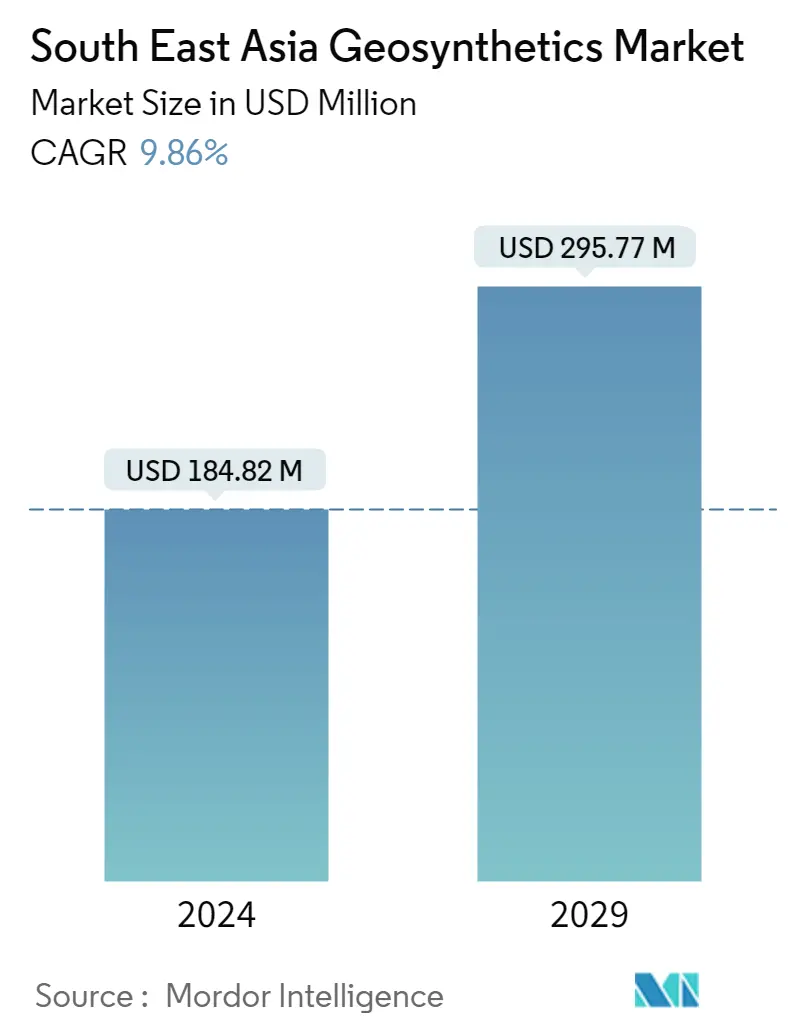Market Size of South East Asia Geosynthetics Industry

| Study Period | 2019 - 2029 |
| Base Year For Estimation | 2023 |
| Market Size (2024) | USD 184.82 Million |
| Market Size (2029) | USD 295.77 Million |
| CAGR (2024 - 2029) | 9.86 % |
| Market Concentration | Low |
Major Players
*Disclaimer: Major Players sorted in no particular order |
South East Asia Geosynthetics Market Analysis
The South East Asia Geosynthetics Market size is estimated at USD 184.82 million in 2024, and is expected to reach USD 295.77 million by 2029, growing at a CAGR of 9.86% during the forecast period (2024-2029).
The market was negatively impacted by COVID-19 in 2020 as several industries, such as construction, manufacturing, and other industries, have been halted, and the shutdown of road and rail network projects also slowed down the growth of the geosynthetics market. Currently, the market has recovered from the pandemic and is growing at a significant rate.
- The growing roadways and railways construction projects, and the growing concerns regarding environmental protection are major factors driving the growth of the market studied.
- However, installation damage threats are likely to restrain the growth of the studied market.
- Nevertheless, growing investment in the mining sector is likely to create lucrative growth opportunities for the Asia-Pacific market.
- Indonesia represents the largest market over the forecast period due to the consumption from various applications such as drainage, soil erosion control, liquid/gas storage, reinforcement, and others.
South East Asia Geosynthetics Industry Segmentation
Geosynthetics are polymeric (plastic) man-made products that are used to solve geotechnical problems in various construction projects. They may be planar, strips, or three-dimensional structures. The prefix "geo" indicates that the product is related to geological materials such as rocks, soil, and earth.
The Southeast Asia geosynthetics market is segmented by material, type, function, application, and geography. By material, the market is segmented into polypropylene, polyethylene, polyester, and other materials (polystyrene, polyvinyl chloride, and natural fibers). By type, the market is segmented into geotextile, geomembrane, geocomposite, geosynthetic liner, and other types (geogrid, geonet, geofoam, geocell, and geopipe). By function, the market is segmented into separation, drainage, filtration, reinforcement, and moisture barrier). By application, the market is segmented into construction, transportation, environmental, and other applications (agriculture, mining, oil and gas, etc.). The report also covers the market size and forecasts for the 6 major countries in the region. For each segment, the market sizing and forecasts are provided in terms of value (USD).
| Material | |
| Polypropylene | |
| Polyethylene | |
| Polyester | |
| Other Materials (Polystyrene, Polyvinyl Chloride, Natural Fibers) |
| Type | |
| Geotextile | |
| Geomembrane | |
| Geocomposite | |
| Geosynthetic Liner | |
| Other Types (Geogrid, Geonet, Geofoam, Geocell, Geopipe) |
| Function | |
| Separation | |
| Drainage | |
| Filtration | |
| Reinforcement | |
| Moisture Barrier |
| Application | |
| Construction | |
| Transportation | |
| Environmental | |
| Other Applications (Agriculture, Nursery) |
| Geography | |
| Indonesia | |
| Malaysia | |
| Vietnam | |
| Philippines | |
| Thailand | |
| Singapore | |
| Rest of South East Asia |
South East Asia Geosynthetics Market Size Summary
The South East Asia Geosynthetics Market is experiencing a robust recovery and growth trajectory following the setbacks caused by the COVID-19 pandemic. The market is driven by the increasing construction activities in roadways and railways, alongside heightened environmental protection concerns. Geosynthetics, known for their versatility in enhancing roadway performance through applications such as separation, filtration, and reinforcement, are becoming integral in civil engineering projects across the region. The demand for these materials is expected to rise significantly, supported by numerous infrastructure projects in countries like Indonesia, Malaysia, Thailand, and the Philippines. These projects include major toll roads, bridges, and railway expansions, which are pivotal in driving the market's expansion.
Indonesia is poised to dominate the geosynthetics market in South East Asia, fueled by extensive infrastructure investments and the need for sustainable land management solutions to combat soil erosion. The country's ambitious projects, such as the development of its new capital city, Nusantara, and various toll roads, are set to boost the demand for geosynthetics. The market is characterized by its fragmented nature, with key players like ACE Geosynthetics and HUESKER Synthetic GmbH actively contributing to its growth. Innovations such as recycled PET geogrids and reflective membranes for photovoltaic projects are further enhancing the market's appeal. Overall, the geosynthetics market in South East Asia is expected to witness significant growth, driven by infrastructure development and technological advancements.
South East Asia Geosynthetics Market Size - Table of Contents
-
1. MARKET DYNAMICS
-
1.1 Drivers
-
1.1.1 Growing Roadways and Railways Construction Projects
-
1.1.2 Growing Concerns Regarding Environmental Protection
-
1.1.3 Other Drivers
-
-
1.2 Restraints
-
1.2.1 Installation Damage Threat
-
1.2.2 Other Restraints
-
-
1.3 Industry Value-Chain Analysis
-
1.4 Porter's Five Forces Analysis
-
1.4.1 Bargaining Power of Suppliers
-
1.4.2 Bargaining Power of Buyers
-
1.4.3 Threat of New Entrants
-
1.4.4 Threat of Substitute Products and Services
-
1.4.5 Degree of Competition
-
-
-
2. MARKET SEGMENTATION (Market Size in Value)
-
2.1 Material
-
2.1.1 Polypropylene
-
2.1.2 Polyethylene
-
2.1.3 Polyester
-
2.1.4 Other Materials (Polystyrene, Polyvinyl Chloride, Natural Fibers)
-
-
2.2 Type
-
2.2.1 Geotextile
-
2.2.2 Geomembrane
-
2.2.3 Geocomposite
-
2.2.4 Geosynthetic Liner
-
2.2.5 Other Types (Geogrid, Geonet, Geofoam, Geocell, Geopipe)
-
-
2.3 Function
-
2.3.1 Separation
-
2.3.2 Drainage
-
2.3.3 Filtration
-
2.3.4 Reinforcement
-
2.3.5 Moisture Barrier
-
-
2.4 Application
-
2.4.1 Construction
-
2.4.2 Transportation
-
2.4.3 Environmental
-
2.4.4 Other Applications (Agriculture, Nursery)
-
-
2.5 Geography
-
2.5.1 Indonesia
-
2.5.2 Malaysia
-
2.5.3 Vietnam
-
2.5.4 Philippines
-
2.5.5 Thailand
-
2.5.6 Singapore
-
2.5.7 Rest of South East Asia
-
-
South East Asia Geosynthetics Market Size FAQs
How big is the South East Asia Geosynthetics Market?
The South East Asia Geosynthetics Market size is expected to reach USD 184.82 million in 2024 and grow at a CAGR of 9.86% to reach USD 295.77 million by 2029.
What is the current South East Asia Geosynthetics Market size?
In 2024, the South East Asia Geosynthetics Market size is expected to reach USD 184.82 million.

